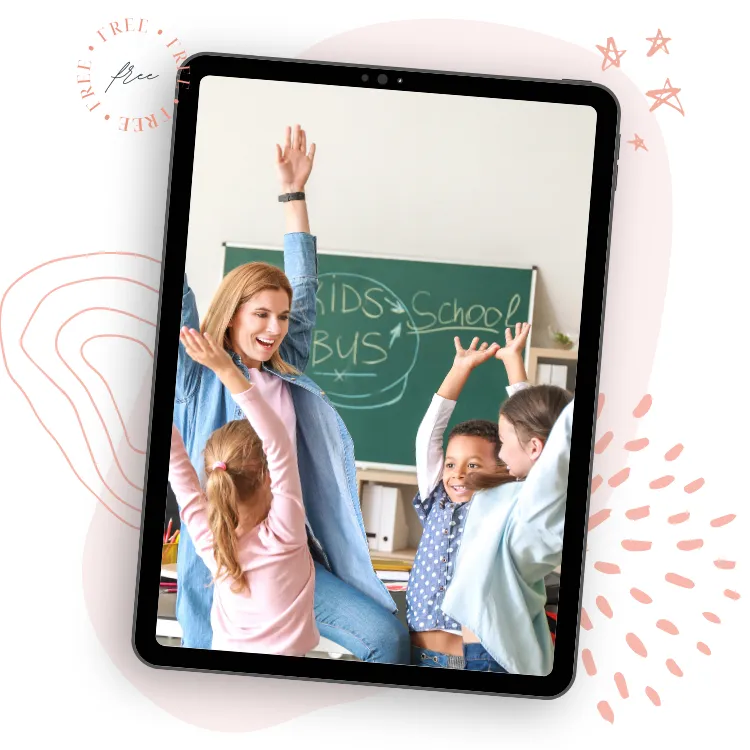When Phonics Isn't Enough,
Rhythm Bridges The Gap.
For children still learning to decode, rhythm strengthens phonological awareness. For those who can already decode, it builds fluency, ease and understanding.
Rhythm for Reading doesn't replace phonics, it's a complementary approach. Rhythm clarifies the patterns and timing that allow reading to flow naturally, helping children progress from their current stage with ease and precision.
You've done everything phonics can offer, yet some pupils still struggle to read with ease. It's not your fault, and it's not theirs. For years, phonics has been the foundation of reading, but when it falls short, rhythm provides the missing link.
Backed by UCL Institute of Education doctoral research, Rhythm for Reading helps you to spark fluency and understanding in every learner.
Inside Rhythm for Reading Online CPD, you’ll discover how to:
⦿ Spot what’s sabotaging fluency and fix it with rhythm.
⦿ Use rhythm to capture and restructure attention, keeping it long enough for real learning to land.
⦿ Apply rhythm techniques that make progress feel like a win for you and your pupils.
Grounded in research. Proven in classrooms.
This isn’t theory. Developed in a five year UCL Institute of Education research project and published in the Research Studies in Music Education Journal, Rhythm for Reading has helped countless children move from stuck to fluent. Teachers report remarkable progress in just ten weeks, with pupils understanding more deeply and enjoying reading for the first time.
The data backs it up and the smiles in the classroom say it all.
You don't have to rely solely on phonics.
Join Rhythm for Reading Online CPD and discover how rhythm can unlock fluency and understanding for every child.
If you've ever wondered why some children still struggle, even after all the phonics interventions, you're not alone.

If Phonics Was Supposed To Fix Reading… Why Are The Gaps Still Growing?
You’ve done everything right — so why aren’t the results matching your effort?
You’ve thrown every intervention at the wall, but the same children are still stuck.
You want progress you can see — in their books, on the walls, in the data.
You’re open to something different, as long as it’s proven and not 'fluff'.
And you’re done with crossing your fingers and waiting out another term of 'let’s just see.'
You've seen the same patterns repeat, no matter how many strategies you try. The truth is some children are still being left behind, and that's heartbreaking for any teacher who cares deeply about their progress. When those children finally start to catch up, it's one of the most rewarding moments in teaching. Grounded in research from UCL Institute of Education, Rhythm for Reading was designed to make that transformation possible.
It’s Time to Stop Patching Over the Cracks & Fix the Deeper Problem
Rhythm for Reading Online CPD
30 Weeks, 3 Terms, Real Progress
Each week, enrolled teachers get:
🎥 A short, energising video session (10–30 min) to lift the week.
📞 A quick, focused support call — so no one is ever stuck or guessing.
🔬 Tools that actually work for the children that phonics left behind.
When you see those children light up with confidence, reading fluently and keeping up with their peers, it changes everything. That's the kind of progress that reminds you why you became a teacher in the first place. Join Rhythm for Reading today and start creating those moments in your classroom.

Ready to go deeper?
When you understand how rhythm connects the brain, body and language, everything changes. You'll start to see reading not as a struggle to fix, but as a rhythm to unlock. These proven methods help you go beyond phonics and create lasting breakthroughs for learners at risk of falling further behind.
✅ Identify and resolve reading blocks using rhythm, so that every child can finally feel confident and capable.
✅ Refocus children’s attention with joy and flow, turning frustration into fun and focus.
✅ Learn neuroscience-backed techniques that boost progress fast, giving you results in weeks, not months.
✅ Trusted by primary, secondary and special schools with measurable improvements in under 10 weeks.
Success Worth Celebrating: Real Teachers & Real Results
Every breakthrough tells a story. These are the moments that remind us why this work matters:
when children rediscover their confidence, and teachers see progress they once thought was impossible.
10 MONTH GAIN
How amazing would it be if things were like this instead?
"I'm happy because
I liked the really incredible
music for saying the letters."
(Year 3 child)
This child's teacher said:
"Enjoying reading - has moved up two book bands."
[10 month gain in reading accuracy age at the end of 10 weeks.
25 MONTH GAIN
How would you feel if you saw these results every term?
"My reading's got better. I've been practising more and it's more interesting."
(Year 3 child)
This child's teacher said:
"Showing enjoyment of reading. Improved sentence structure in writing."
[25 month gain in reading comprehension age,
after the 10 weeks.]
33 MONTH GAIN
How would you feel if your pupils said this?
"My difference has been amazing and it makes me feel so happy and excited!"
(Year 3 child)
This child's teacher said:
"She has shown increasing levels of enthusiasm in her writing this term."
[33 month gain in reading comprehension age after 10 weeks.]
Rhythm for Reading CPD: Step by Step
A three-term journey designed to help teachers confidently deliver
Rhythm for Reading and
see measurable progress in their pupils' reading.
What's included?
Each term of Rhythm for Reading CPD builds your confidence and skills step by step. You'll work with a fresh group of children each term and move from guided hands-on learning to fully independent delivery, supported every week with practical tools, reflection and expert guidance. By the end of the programme you'll feel equipped to use the Rhythm for Reading in your school to bring joyful support to children at risk of falling behind their peers.
Term 1 'Breakthrough'
Step into the Rhythm for Reading journey with video-supported sessions thatbring the method to life.
Video-supported teaching: Co-teach with me via a continuous video, pausing for each task to experience your pupils' rhythm in action (30 mins per week).
Weekly check-in calls Discuss learning objectives using the Roadmap, track pupil progress with the Session Planner, and reflect on your own teaching experience through Self-Reflection,
(15 mins per call).
Term 2 'Momentum'
Build confidence and flow as you move from guided delivery to dynamic independent teaching
Dynamic teaching: Light touch teaching cues support your delivery, with prompts embedded in the resources to help you move smoothly from task to task
(20 mins per week).
Weekly check-in calls Continue using the Roadmap, Session Planner and Self-Reflection tools, whilst also tracking pupils' reading progress with the Fluency Tracker (15 mins per call).
Term 3 'Deep integration'
Refine your delivery of the programme with flexibility and responsiveness, meeting the needs of every learner.
Flexible responsive teaching: Learn to differentiate intuitively, using nuanced approaches to meet a wide range of pupil needs as you deliver Rhythm for Reading,
(10 mins per week).
Weekly check-in calls Focus is on individual differences, planning and reflecting on sessions, while exploring strategies to support pupils with SEND.
(15 mind per call)
Next Cohort Starts:
5th January '26
Price per teacher
£251.00
You've seen how the programme supports you every step of the way. Now, when you're ready, you can join the next cohort and feel fully supported as you bring Rhythm for Reading to life in your school.
WHAT'S INCLUDED -
✅ 10 weeks of video-led training
✅ 30 weeks of personalised support
✅ Proven results in under a term
Register now to start in January '26 and take this next step with a community that believes in you and your potential.
"It supplements & extends our synthetic phonics programme..."

8 Years of High Outcomes
"Dr Marion has
run Rhythm for Reading at our schoolfor over 10 years
producing high outcomes.”
— Headteacher, London
Attitudes, Engagement, Fluency
"It supplements & extends our synthetic phonics programme leading to improvements in attitudes to reading, engagement with the text & fluency.”
— Headteacher, London
Reading 'Suddenly Clicks into Place'
”Things that we’ve been trying to get to happen for two or three years suddenly click into place after six weeks of the programme.”
— Lower KS2 Phase Lead, London
FAQs
Isn't this just a music intervention?
There are five reasons why this is NOT a music programme. There’s no:
singing,
composing,
creativity,
improvisation
musical instruments.
However, there are a few activities that are ‘musical’:
The children practise rhythmic patterns and in the background, there’s our own specially-composed music, which focuses the children’s attention.
Therefore, they learn to read music and to keep time. and these skills transfer to improved fluency in early reading development.
How is this reading, not music?
There are 7 reasons why this IS a reading programme:
1. Like reading, it uses a system of symbols -marks on the page.
2. The symbol system is decoded by using letter names.
Pupils:
3. Read the symbol system from left to right.
4. Practise decoding the symbols using call and response - similar to phonics lessons.
5. Read symbols fluently, even in the first session.
6. Actions and stories help the children with decoding.
7. Decoding is fast-paced and highly structured.
There are 3 ways in which this programme DIFFERS from other reading programmes:
1. Children do not read words or sentences.
2. Symbols are decoded into rhythmic patterns.
3. Rhythmic patterns are grouped into phrases, which are logically organised and thus encourage anticipation and deepen engagement.
Who is the digital programme for?
It is for the children in either year 2 or year 3 who struggle with any of these challenges: fragmented or fading attention, weak phonological awareness, word-by-word reading that's 'stuck', fragile fluency, patchy comprehension. Children with SEND, EAL, ASD, ,ADHD, SpLD can benefit too. Children with specific language impairment require a different approach.
Do I need to be able to read music?
Teachers do not need to be able to read music.
It is very important that the teacher feels positive about leading the children using rhythm.
This approach is similar to the clapping patterns that most teachers use in the classroom to get the children's attention.
The musical notes that we use are very simple to read and we are confident that all teachers will find this is straightforward.
After all, if a struggling five year old child can pick this up in a few minutes, then a competent adult will be fine!
How does rhythm help?
Rhythm helps in three main ways. Firstly, it introduces a time constraint, which brings an extra dimension of precision, focus and structure to the teaching of early reading. Secondly, a rhythm-based approach lightens the burden of decoding (cognitive loading) and frees up resources for the development of reading fluency. Lastly, rhythm in itself is hypnotic, commands attention and is highly rewarding - thus it's an incredibly powerful teaching tool!
Can I use this every day?
Rhythm boosts fluency through timing, phrasing and joy. That’s why it works.
We can think of this programme as a sweet treat! Using this method on a weekly basis actually increases its potency.
The spacing of the programme sessions allows time not only for full assimilation of rhythm-based techniques, but a powerful sense of anticipation of the next session cultivates an appetite for deeper engagement and learning.
By the same token, making the weekly sessions very short - ideally ten minutes - also increases the intensity of the programme's impact.
You've already taken the first step by exploring what's possible with Rhythm for Reading. When you're ready, we'll be here to guide and support you as you bring
rhythm, confidence and joy into each weekly session.
Together, we'll help your pupils thrive.
Your journey towards joyful
Rhythm for Reading sessions starts here.
All rights reserved. © Copyright 2025 Rhythm for Reading Services Ltd..